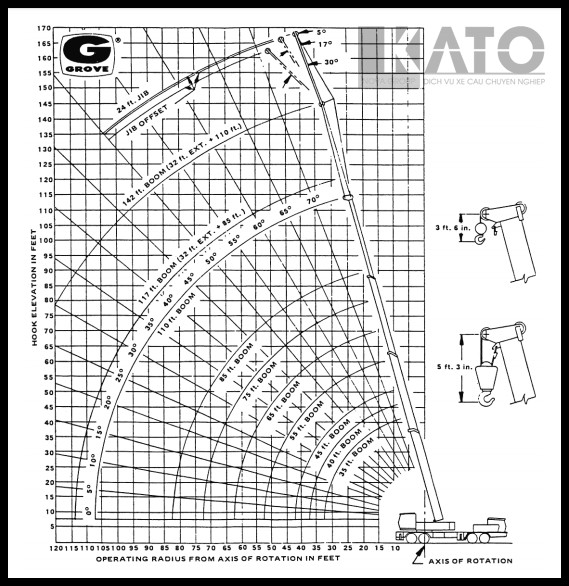In the context of thriving industries and construction, cranes play a pivotal role in enhancing work efficiency. In particular, the Kato 50-ton all-terrain crane is widely used in Vietnam due to its flexibility and powerful operating capabilities. To ensure safety and optimal performance, consulting the Kato crane load chart is crucial. This article from Xe Tải Mỹ Đình (My Dinh Truck) will provide a detailed guide on how to look up and understand the load chart of the Kato 50-ton crane.
Kato 50-Ton Crane and Its Important Role in Industry
The Kato 50-ton all-terrain crane stands out with its flexible mobility on various terrains, especially construction sites, seaports, factories, and industrial parks. The tire design allows the crane to move quickly between different work locations, saving time and transportation costs.
With a maximum lifting capacity of 50 tons and a lifting height of up to 43 meters, the Kato 50-ton crane meets a variety of work needs such as:
- Lifting and moving heavy goods and construction materials.
- Loading and unloading containers at ports and warehouses.
- Supporting the installation of steel structures, machinery, and industrial equipment.
- Constructing civil and industrial buildings.
However, to maximize performance and ensure absolute safety, consulting the Kato crane load chart before each shift is an indispensable step.
 Kato 50 Ton Crane Load Chart
Kato 50 Ton Crane Load Chart
Kato 50-Ton Crane Load Chart: A “Map” for Safety and Efficiency
The crane load chart, also known as the load table, is an important technical document that provides detailed information about the crane’s lifting capacity in different working conditions. For the Kato 50-ton crane, the load chart is a “guide” that helps operators determine the maximum safe load that the crane can lift at a specific radius and boom length.
The load chart is usually presented in the form of a matrix, in which:
- Horizontal rows: Represent the crane’s operating radius (the distance from the center of the crane to the load being lifted), usually measured in meters (m).
- Vertical columns: Represent the lifting capacity allowed corresponding to each operating radius and different boom lengths, usually measured in tons (tons).
- Sub-columns: Divide the lifting capacity according to different boom lengths (e.g., 10.8m, 14.45m, 18.1m, …).
Consulting the Kato crane load chart helps operators:
- Ensure safety: Avoid lifting beyond the allowable load, preventing the risk of overturning, cable breakage, or equipment damage.
- Optimize performance: Choose a lifting method suitable for the load and lifting position, ensuring the work is done quickly and efficiently.
- Extend crane life: Operating at the correct load helps minimize wear and tear on the crane’s components.
Reading and Understanding the Kato 50-Ton Crane Load Chart
To consult the Kato crane load chart accurately, operators need to understand how to read and interpret it. Here is a detailed guide:
- Determine the operating radius: Measure the distance from the center of the crane to the position where the load needs to be lifted. For example, if the operating radius is 7 meters.
- Select the boom length: Determine the boom length that is suitable for the height and lifting position. For example, choose a boom length of 14.45 meters.
- Consult the load chart: Find the intersection between the “Operating Radius 7.00m” row and the “14.45 m Main Boom” column on the load chart.
- Read the allowable lifting capacity: The value at the intersection is the maximum allowable lifting capacity. In this example, the maximum lifting capacity is 20.30 tons.
Important notes:
- The load chart is for reference only and applies to ideal conditions when the crane is operating in the best possible state.
- The actual load may be affected by many factors such as terrain, slope, wind speed, and crane condition.
- Always consult the Kato crane load chart carefully and follow the manufacturer’s safety instructions.
Factors Affecting Lifting Capacity and Operational Safety
In addition to consulting the Kato crane load chart, operators need to be aware of the factors that can affect the actual lifting capacity and operational safety:
- Terrain: The crane needs to be placed on flat, solid ground. Sloping, sinking terrain can reduce load capacity and cause danger.
- Wind: Strong winds can create forces on the boom and load, reducing stability and safe lifting capacity.
- Crane condition: Crane components such as the boom, cables, hooks, and hydraulic system need to be regularly maintained and in good working order. Any damage can affect lifting capacity and safety.
- Operating skills: Operators need to be experienced and well-trained in safe crane operation and accurate Kato crane load chart interpretation.
Practical Applications and Notes When Consulting the Kato 50-Ton Crane Load Chart
In practice, consulting the Kato crane load chart is applied in all lifting stages, from loading and unloading goods, assembling components, to lifting and lowering equipment. Before each operation, the operator needs to:
- Clearly identify the load weight: Check the information on the packaging, technical documents, or use load measuring equipment.
- Assess working conditions: Observe the terrain, weather, and surrounding factors that may affect safety.
- Consult the load chart: Determine the maximum safe lifting capacity for the required operating radius and boom length.
- Choose a safe lifting method: Ensure the load weight does not exceed the allowable load and comply with safety rules.
Advice from Xe Tải Mỹ Đình experts:
- Always consult the Kato crane load chart before performing any lifting operation.
- Read the manufacturer’s instructions and load chart carefully.
- Regularly check and maintain the crane to ensure safe operation.
- Train and improve the skills of the crane operator team.
Conclusion
Consulting the Kato crane load chart is a key factor in ensuring safety and efficiency during operation. Understanding the load chart and the influencing factors helps operators make accurate decisions, optimize work performance, and extend crane life. Xe Tải Mỹ Đình hopes this article has provided useful information to our readers. If you have any questions or need advice on Kato cranes, do not hesitate to contact us via hotline 0977 550 833.

